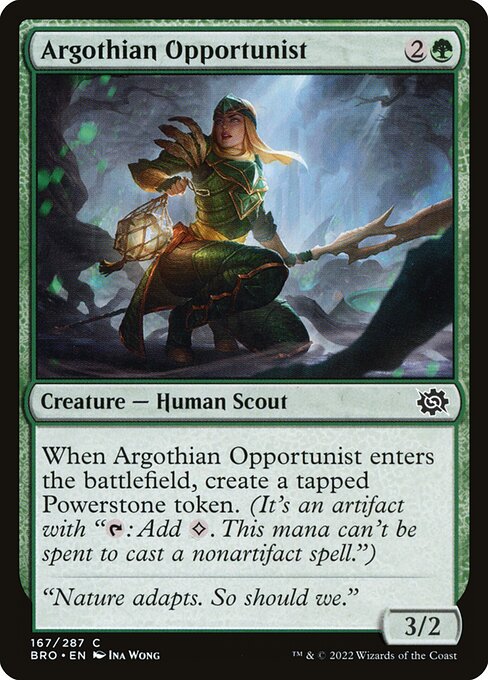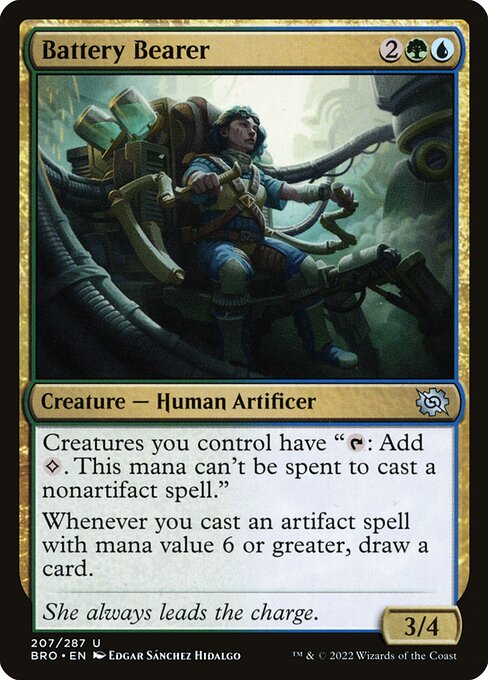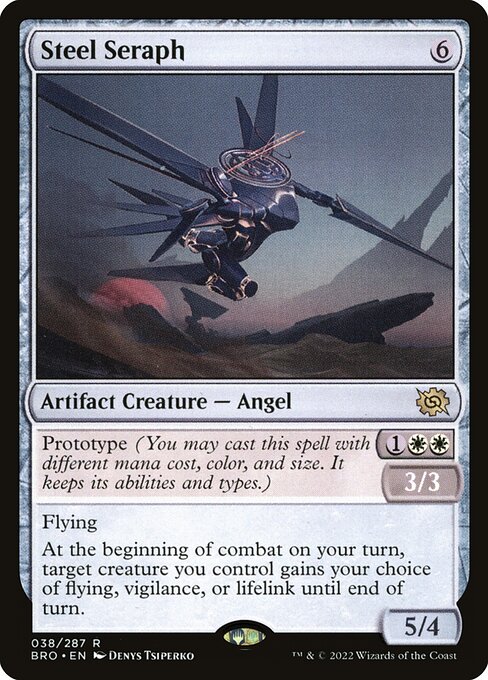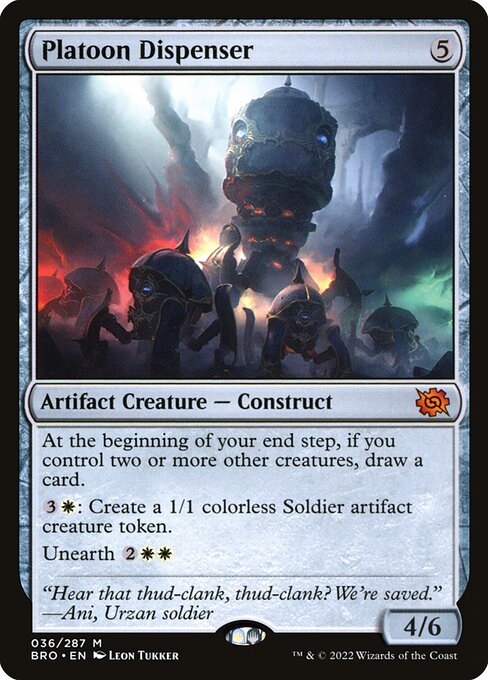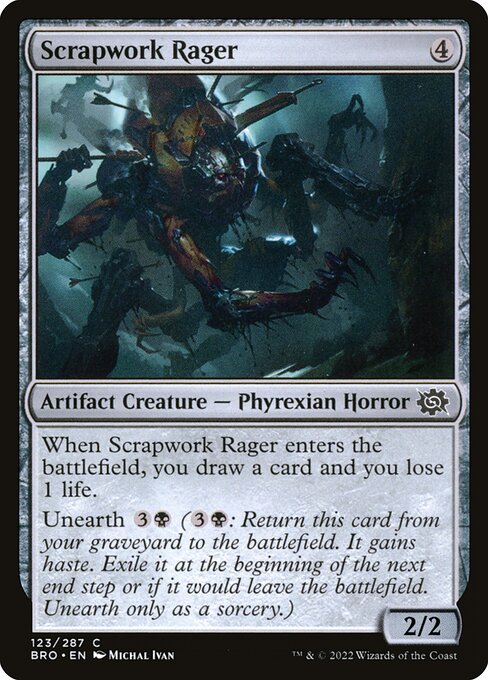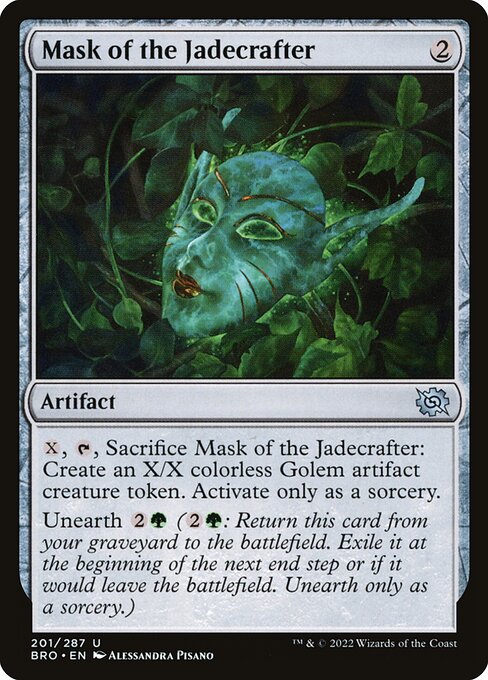Table of Contents
Hey everyone! We’re here to get in depth on the mechanics of The Brothers’ War. We’re going to be explaining them as well as discussing their applications in limited. The better you know all of the interactions the bigger of a head start you’ll have on the competition on day one. The big three mechanics to know here are Powerstones, Prototype, and Unearth.
Powerstones
This is the big underlying theme of the set and the majority of the cards were clearly designed with that in mind. Powerstones have been in Magic for a very long time (Worn Powerstone, Powerstone Shard, etc) and we even got a preview of this particular form of them on Karn, Living Legacy. This is their introduction party for them as an officially official thing.
What does a powerstone do? A lot more than you would think at first glance. It is an artifact that allows you to tap it for a colorless mana, but that mana can’t be spent to cast a nonartifact spells. While you might read that and think, “How many artifacts am I really going to have?”, in actuality you should be asking, “How am I going to abuse these?”.
Using Powerstones to ramp to massive artifacts is great and all when it works out. Once we leave magical Christmas land, we realize that there is a limit to how many of those you can put in a deck without getting ran over. To actually maximize the value of powerstones, you want to look into using them for activated abilities or even as sacrifice fodder. I’m not saying to ignore using them to cast artifacts, I’m saying to look at the whole spectrum of possibilities.
There are plenty of mana sinks floating around even at common such as Ambush Paratrooper or Third Path Savantto dump that extra powerstone mana into. Unearth is another great way to take advantage of that extra mana, but we’ll be touching on that later. You can also filter it into “real” mana with Energy Refractor or Chromatic Star.
The biggest question I get every set is how much of a card is this new mechanic worth. In this case, it’s going to vary heavily deck by deck. If your deck has a couple great high-end artifacts, multiple mana sinks, and a couple of Powerstone Fractures, then it’s almost worth a whole card. It’s that valuable there because it is functioning as a land with potential upside. If you somehow end up in a deck without any way to use it, it’s basically worthless. That’s a pretty big range and most of the time it’s going to be somewhere in the middle leaning more towards the former. That leaves my initial impression as about 2/3rds of a card.
No matter how fun it sounds, I don’t think it’s wise to go all in on the “make a bunch of powerstones and play tons of huge monsters” plan. Getting your top end spell Disenchanted already feels really bad without complicating matters by spending multiple turns on ramping to it. I prefer to look at them more as almost incidental extra game pieces that help your overall plan. Basically, try to find a balance between efficient ways to create powerstones and take advantage of them without leaving yourself vulnerable by overcommitting.
Prototype
Prototype is a new mechanic that represents the earlier stages of a machines production. You can pay the prototype cost (which costs colored mana) to drop it earlier and change the stats while maintaining the text box. It does the same thing as the full cost version, but smaller and cheaper. One of the ways to look at this is that it is similar to a double-faced card.
If you pay the protoype cost, it remains that version until it leaves the battlefield. That means no clone shenanigans. You could blink it and have it come back with its big boy pants on, but they intentionally neglected to put any of those effects in the set. The easiest way to get the large mamma jammas on the field quickly is to trade off the prototype version (or discard it) and bring it back with Repair and Recharge or No One Left Behind.
Most of these have all played out really well so far because it fills two parts of the curve with only one card. I hate saying it’s similar to kicker because there are some pretty significant differences to how they react to other effects, but it has the same good early, good late vibe to it.
Unearth
This is a returning mechanic that was originally introduced in Shards of Alara and has made plenty of appearances in the meantime. It allows you to pay the unearth cost to return it to the battlefield with haste and you exile it during your next end step or if it would leave the battlefield. You can only play it a as a sorcery. The biggest difference from before is that it can now be on permanents when it was previously just on creatures.
The exile when it leaves the battlefield takes away most of the normal shenanigans like bouncing it for additional value. There is Ashnod's Intervention which was designed to get around this, but isn’t exactly the type of card you bring home to meet your parents.
One of the great things about Unearth is that your opponent is heavily disincentivized to block the creature since you are going to lose it at the end of turn anyway. After all life total is a resource. That means that you can usually sneak in some damage and then sacrifice it for some additional value.
Another way to take advantage of Unearth is to combine it with self-mill as every one you hit is more free value. The same applies to discard since you are still getting something out of the card later.
Over all it is a very solid mechanic that just gives you a little extra oomph later in the game.
Wrap Up
That brings us to the end of our look into the mechanics of The Brothers’ War. Overall, they seem very balanced with no power level concerns whatsoever. I look forward to spending the week jamming drafts until my wife drags me away from my computer (mostly because she wants her turn to draft).
Don’t forget to check back tomorrow for my breakdown on the archetypes including example skeletons of each!
If you have any questions, let me know in the comments below.
You can also find me at:
Premium >
Enjoy our content? Wish to support our work? Join our Premium community, get access to exclusive content, remove all advertisements, and more!
- No ads: Browse the entire website ad-free, both display and video.
- Exclusive Content: Instant access to all exclusive articles only for Premium members, at your fingertips.
- Support: All your contributions get directly reinvested into the website to increase your viewing experience!
- Discord: Join our Discord server, claim your Premium role and gain access to exclusive channels where you can learn in real time!
- Special offer: For a limited time, use coupon code L95WR9JOWV to get 50% off the Annual plan!


























